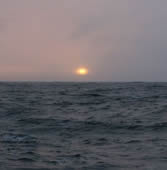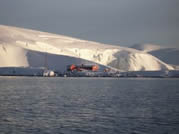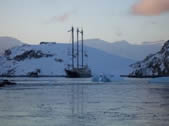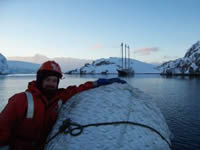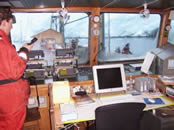
 |
| Academic Departments | Student Services | Alumni | Research | Outreach | Diversity |
| 1 | 2 | 3 | 4 | 5 | 6 | |
| 7 | 8 | 9 | 10 | 11 | 12 | 13 |
| 14 | 15 | 16 | 17 | 18 | 19 | 20 |
| 21 | 22 | 23 | 24 | 25 | 26 | 27 |
| 28 | 29 | 30 | 31 |
| 1 | 2 | 3 | ||||
| 4 | 5 | 6 | 7 | 8 | 9 | 10 |
| 11 | 12 | 13 | 14 | 15 | 16 | 17 |
| 18 | 19 | 20 | 21 | 22 | 23 | 24 |
| 25 | 26 | 27 | 28 | 29 | 30 |
Daily Journals
May 30, 2006 - South of the Antarctic Circle, Adelaide Island
We were running into dense snow squalls last night, and had to turn north for a while until the weather cleared. With visibility so poor, and the prospect of finding ice in our path a particular hazard, it was the prudent thing to do. At present (1100) we are performing a rock dredge trawl off the WSW corner of Adelaide Island. Adelaide Island is a large, mainly ice-covered island, 75 miles long and 20 miles wide, lying at the north side of Marguerite Bay off the west coast of the Antarctic Peninsula. This island was discovered in 1832 by a British expedition under John Briscoe, and named by him for Queen Adelaide of England. Getting to Know You Izzy Williams Pam Polloni Back to the Science Plankton tows continue to garner the plankton Rudi Scheltema is looking for on this trip. Today they are seeing lots of Pilidium, the helmet-shaped larva that becomes a ribbon worm. The bottom or benthic trawls had not been yielding much real treasure in the last few tries, but tonight they pulled up a mother lode of crinoids, worms, stars, small fish, giant sea cucumber and one very large scale worm, yet to be identified. Perhaps unnamed at the moment, but certainly well documented. Photographer extraordinaire Susie Balser was on that thing like a robin on a …well, a spring worm! All I could think of when looking at this approx. 10-inch by 3-inch scaled mega-annelida was…
Don't hesitate to email questions to us at outreach@lmg.usap.gov |
Longitude/Latitude: S67° 15.143’ W69° 27.442’ Temperature: Wind: N 17kn Wind Chill: -13.8°C
Menu: Lamb shoulder chops, mac and cheese, Spanish rice, okra!, big budda beans, salad, yellow cake, and cookies; Some kind of steak, chicken wings in Spanish rice, cauliflower, brussels sprouts, and lunch’s desserts.
Photos:High Noon in Marguerite Bay, Antarctica. 5/30/06 [Photo by Ken Halanych]
…”Just when you thought it was safe to go back in the water….” [Photo by S. Balser]
The French schooner Sedna in Dallmann Bay. [Photo by Rick Lichtenhan]
Welcome supplies on their way to Sedna (Palmer Station's Toby Koffman). [Photo by Rick Lichtenhan]
LMG MT, Stian Alesandrini aboard Sedna in Dallmann Bay. [Photo by Rick Lichtenhan] |
- Alabama Agricultural Experiment Station
- Alabama Cooperative Extension System
- Auburn Online Community
- Bookstore
- Center for Diversity
- Crisis/Incident Assistance
- Diversity and Multicultural Affairs
- Financial Aid
- Hotel and Conference Center
- Jule Collins Smith Museum of Fine Art
- Medical Clinic
- Southeastern Raptor Center
- Special Reports
- Students w/ Disabilities
- Theatre
